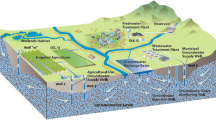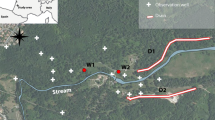Abstract
Efficient management of groundwater resources is important because groundwater availability is limited and, locally, groundwater quality has been impaired because of contamination. Here we present a multi-objective optimization framework for improving the management of a water works that operates with infiltration basins, injection wells and abstraction wells. The two management objectives are to minimize the amount of water needed for infiltration and to minimize the risk of getting contaminated water into the drinking water wells. The management is subject to a daily demand fulfilment constraint. Two different optimization methods are tested. Constant scheduling where decision variables are held constant during the time of optimization, and sequential scheduling where the optimization is performed stepwise for daily time steps. The latter is developed to work in a real-time situation. Case study optimization results are presented for the Hardhof water works in Zurich, Switzerland. It is found that both methods perform better than the historical management. The constant scheduling performs best in fairly stable conditions, whereas the sequential optimization performs best in extreme situations with heavy rainfall or large changes in water demand.







Similar content being viewed by others
References
Ahlfeld DP, Baro-Montes G (2008) Solving unconfined groundwater flow management problems with successive linear programming. J Water Resour Plan Manage 134:404–412
Barán B, von Lücken C, Sotelo A (2005) Multi-objective pump scheduling optimisation using evolutionary strategies. Adv Eng Softw 36:39–47
Bauser G, Franssen HJH, Kaiser HP, Kuhlmann U, Stauffer F, Kinzelbach W (2010) Real-time management of an urban groundwater well field threatened by pollution. Environ Sci Technol 44(17):6802–6807
Bleuler S, Laumanns M, Thiele L, Zitzler E (2003) PISA - a platform and programming language independent interface for search algorithms. ETH Zürich, Computer Engineering and Networks Laboratory. http://www.tik.ee.ethz.ch/sop/pisa/
Chang JX, Huang Q, Wang YM (2005) Genetic algorithms for optimal reservoir dispatching. Water Resour Manag 19:321–331
Cheng AHD, Halhal D, Naji A, Ouazar D (2000) Pumping optimization in saltwater-intruded coastal aquifers. Water Resour Res 36(8):2155–2165
Choudhari S, Raj P (2010) Multiobjective multireservoir operation in fuzzy environment. Water Resour Manag 24(10):2057–2073
Cieniawski SE, Eheart JW, Ranjithan S (1995) Using genetic algorithms to solve a multiobjective groundwater monitoring problem. Water Resour Res 31(2):399–409
Deb K (2001) Multi-objective optimization using evolutionary algorithms. Wiley, Chichester, UK
Deb K, Agrawal RB (1995) Simulated binary crossover for continous search space. Complex Syst 9:115–148
Deb K, Pratap A, Meyariavan T (2001) Constrained test problems for multi-objective evolutionary optimization. Tech. Rep. 200002, Kanpur Genetic Algorithms Laboratory (KanGAL), Kanpur India
Doppler T, Hendricks Franssen HJ, Kaiser HP, Kuhlman U, Stauffer F (2007) Field evidence of a dynamic leakage coefficient for modelling river-aquifer interactions. J Hydrol 347:177–187
Dougherty D, Marryott R (1991) Optimal groundwater-management: 1. Simulated annealing. Water Resour Res 27(10):2493–2508
Engeler I, Hendricks Franssen HJ, Mueller R, Stauffer F (2011) The importance of coupled modelling of variably saturated groundwater flow-heat transport for assessing river-aquifer interactions. J Hydrol 397(3–4):295–305
Erickson M, Mayer A, Horn J (2002) Multi-objective optimal design of groundwater remediation systems: application of the niched Pareto genetic algorithm (NPGA). Adv Water Resour 25:51–65
Farmani R, Savic D, Walters G (2005) Evolutionary multi-objective optimization in water distribution network design. Eng Optim 37(2):167–183
Fowler KR, Kelley CT, Miller CT, Kees CE, Darwin RW, Reese JP, Farthing MW, Reed MS (2004) Solution of a well-field design problem with implicit filtering. Optim Eng 5(2):207–234
Goldberg D (1989) Genetic algorithms in search, optimization, and machine learning. Addison-Wesley
Hendricks Franssen HJ, Kaiser HP, Kuhlmann U, Bauser G, Stauffer F, Müller R, Kinzelbach W (2011) Operational real-time modeling with EnKF of variably saturated subsurface flow including stream-aquifer interaction and parameter updating. Water Resour Res 47, W02532, 20 pp. doi:10.1029/2010WR009480
Karterakis S, Karatzas G, Papadopoulou M (2007) Application of linear programming and differential evolutionary optimization methodologies for the solution of coastal subsurface water management problems subject to environmental criteria. J Hydrol 342:270–282
Katsifarakis K, Petala Z (2006) Combining genetic algorithms and boundary elements to optimize coastal aquifers’ management. J Hydrol 327(1–2):200–207
Kempf T, Freimoser M, Haldimann P, Longo V, Müller E, Schindler C, Styger G (1986) Grundswasservorkommen im Kanton Zürich. Beitraege zur Geologie der Schweiz, Bern
Kollat J, Reed P (2006) Comparing state-of-the-art evolutionary multi-objective algorithms for long-term groundwater monitoring design. Adv Water Resour 29:792–807
Kollat J, Reed P (2007) A computational scaling analysis of multiobjective evolutionary algorithms in long-term groundwater monitoring applications. Adv Water Resour 30:408–419. ISI:000244977700009
Kourakos G, Mantoglou A (2011) Simulation and multi-objective of coastal aquifers in semi-arid regions. Water Resour Manag 25(4):1063–1074
Lopez-Ibanez M, Prasad D, Paechter B (2008) Ant colony optimization for optimal control of pumps in water distribution networks. J Water Resour Plan Manage 134(4):337–346
Mantoglou A, Papantoniou M (2008) Optimal design of pumping networks in coastal aquifers using sharp interface models. J Hydrol 361:52–63
Mantoglou A, Papantoniou M, Giannoulopoulos P (2004) Management of coastal aquifers based on nonlinear optimization and evolutionary algorithms. J Hydrol 297:209–228
Mayer A, Kelley C, Miller C (2002) Optimal design for problems involving flow and transport phenomena in saturated subsurface systems. Adv Water Resour 25:1233–1256
Mckinney D, Lin M (1994) Genetic algorithm solution of groundwater-management models. Water Resour Res 30:1897–1906
Meyer PD, Brill ED (1988) A method for locating wells in a groundwater monitoring network under conditions of uncertainty. Water Resour Res 24(8):1277–1282
Nicklow J, Reed P, Savic D, Dessalegne T, Harrell L, Chan-Hilton A, Karamouz M, Minsker B, Ostfeld A, Singh A, Zechman E (2010) State of the art for genetic algorithms and beyond in water resources planning and management. J Water Resour Plan Manage-Asce 136:412–432
Ormsbee LE, Lansey KE (1994) Optimal control of water supply pumping systems. J Water Resour Plan Manage 120(2):237–252
Ritzel BJ, Eheart JW, Ranjithan S (1994) Using genetic algorithms to solve a multiple objective groundwater pollution containment problem. Water Resour Res (30)5:1589–1603
Siegfried T, Kinzelbach W (2006) A multiobjective discrete stochastic optimization approach to shared aquifer management: methodology and application. Water Resour Res 42:W02,402
Siegfried T, Bleuler S, Laumanns M, Zitzler E, Wolfgang K (2009) Multiobjective groundwater management using evolutionary algorithms. IEEE Trans Evol Comput 13:229–242
SPRING (2010) SPRING software. delta h Ingenieurgesellscaft mbH, Witten, Germany
Tang Y, Reed P, Kollat J (2007) Parallelization strategies for rapid and robust evolutionary multiobjective optimization in water resources applications. Adv Water Resour 30(3):335–353
Zitzler E, Laumanns M, Thiele L (2002) SPEA2: improving the strength Pareto evolutionary algorithm. Tech. Rep. 103, Computer Engineering and Networks Laboratory (TIK), Swiss Federal Institute of Technology (ETH) Zurich, Gloriastrasse 35, CH-8092 Zurich, Switzerland. http://www.tik.ee.ethz.ch/pisa/
van Zyl J, Savic D, Walters G (2004) Operational optimization of water distribution systems using a hybrid genetic algorithm. J Water Resour Plan Manage-Asce 130(2):160–170
Acknowledgements
This work was partly founded by the Danish Strategic Research Council, Sustainable Energy and Environment Programme, Contract no. 09-061392. The authors would like to thank Gero Bauser for sharing information and knowledge about Hardhof water works.
Author information
Authors and Affiliations
Corresponding author
Rights and permissions
About this article
Cite this article
Hansen, A.K., Hendricks Franssen, HJ., Bauer-Gottwein, P. et al. Well Field Management Using Multi-Objective Optimization. Water Resour Manage 27, 629–648 (2013). https://doi.org/10.1007/s11269-012-0125-y
Received:
Accepted:
Published:
Issue Date:
DOI: https://doi.org/10.1007/s11269-012-0125-y




